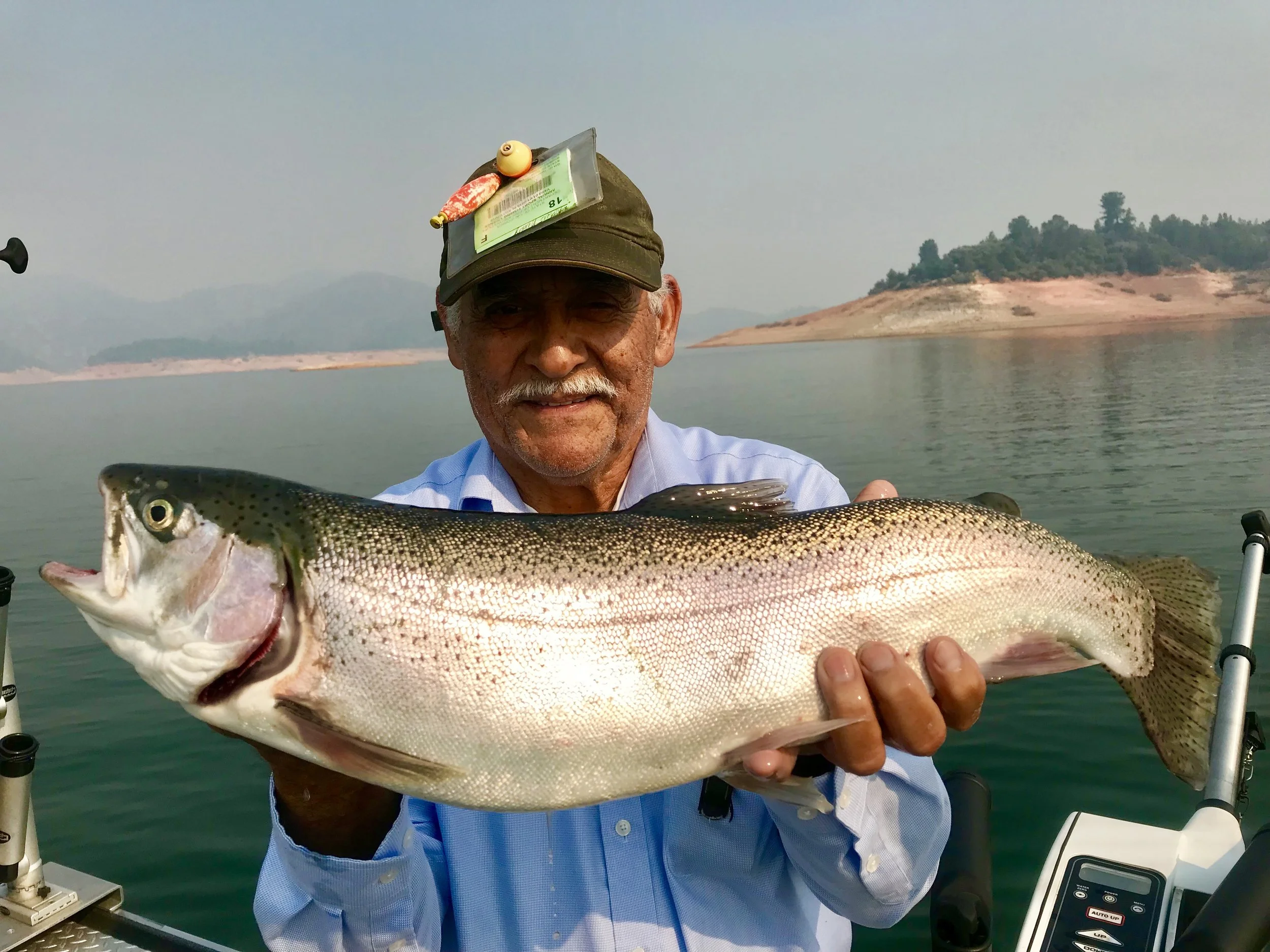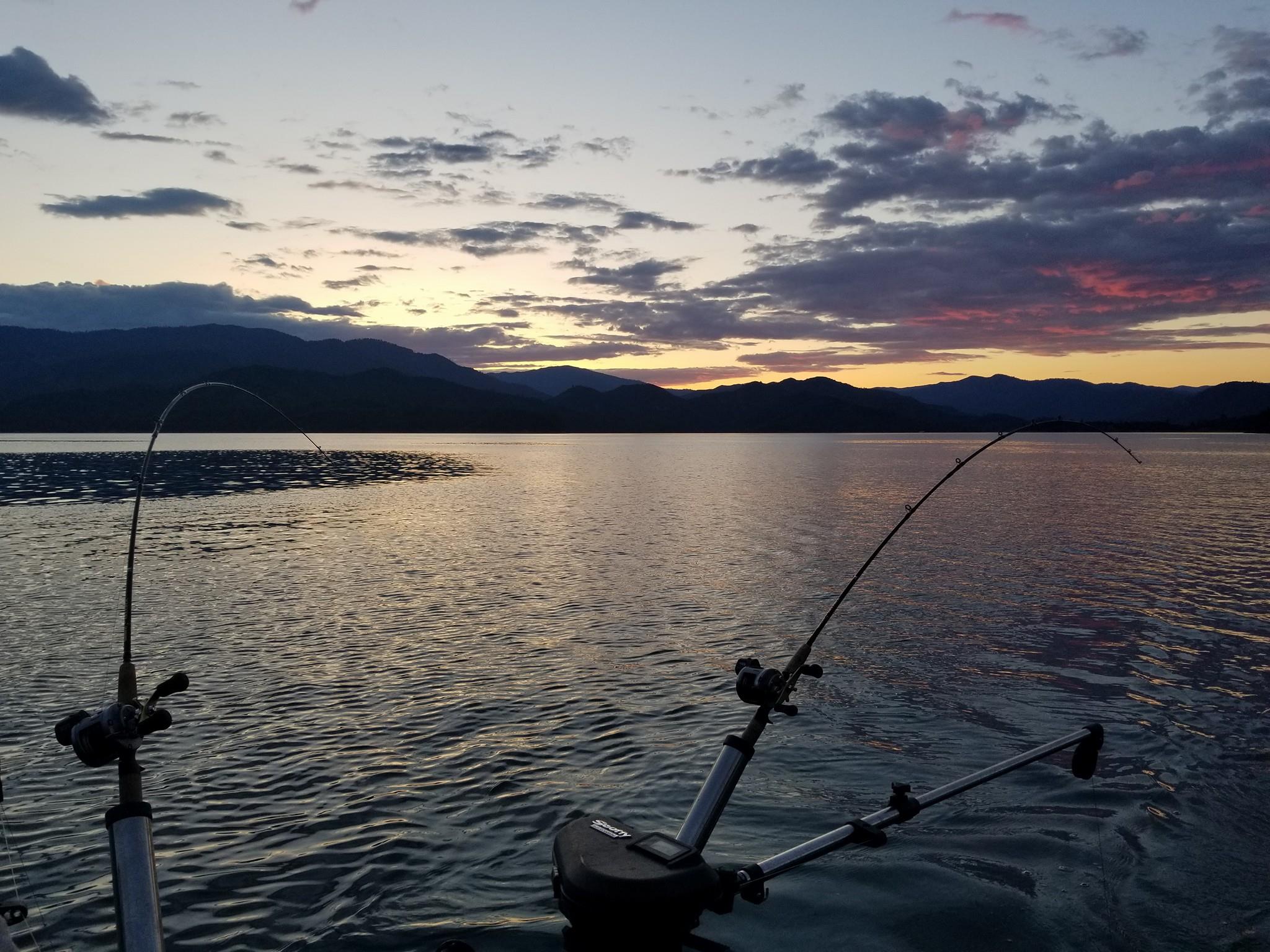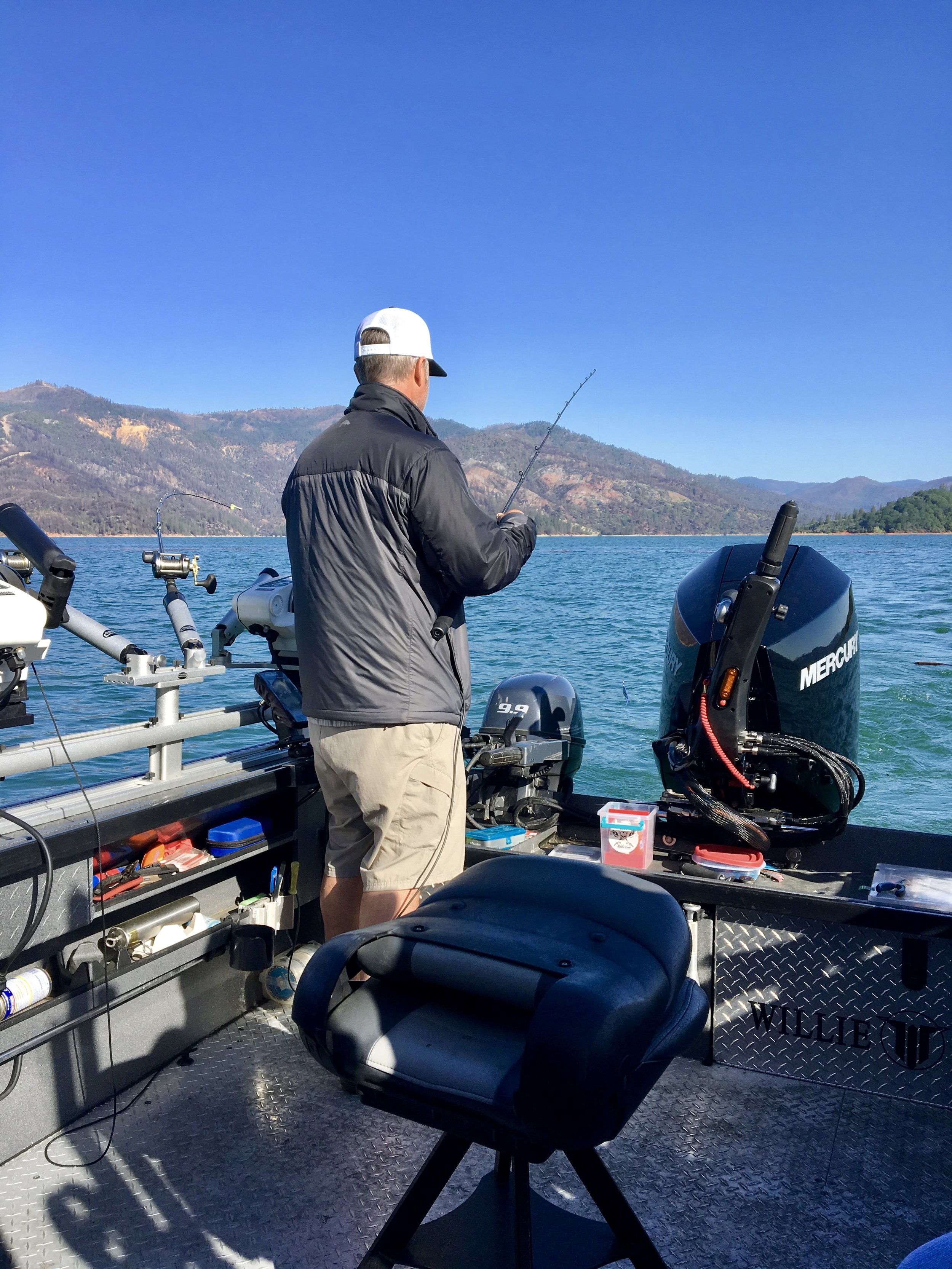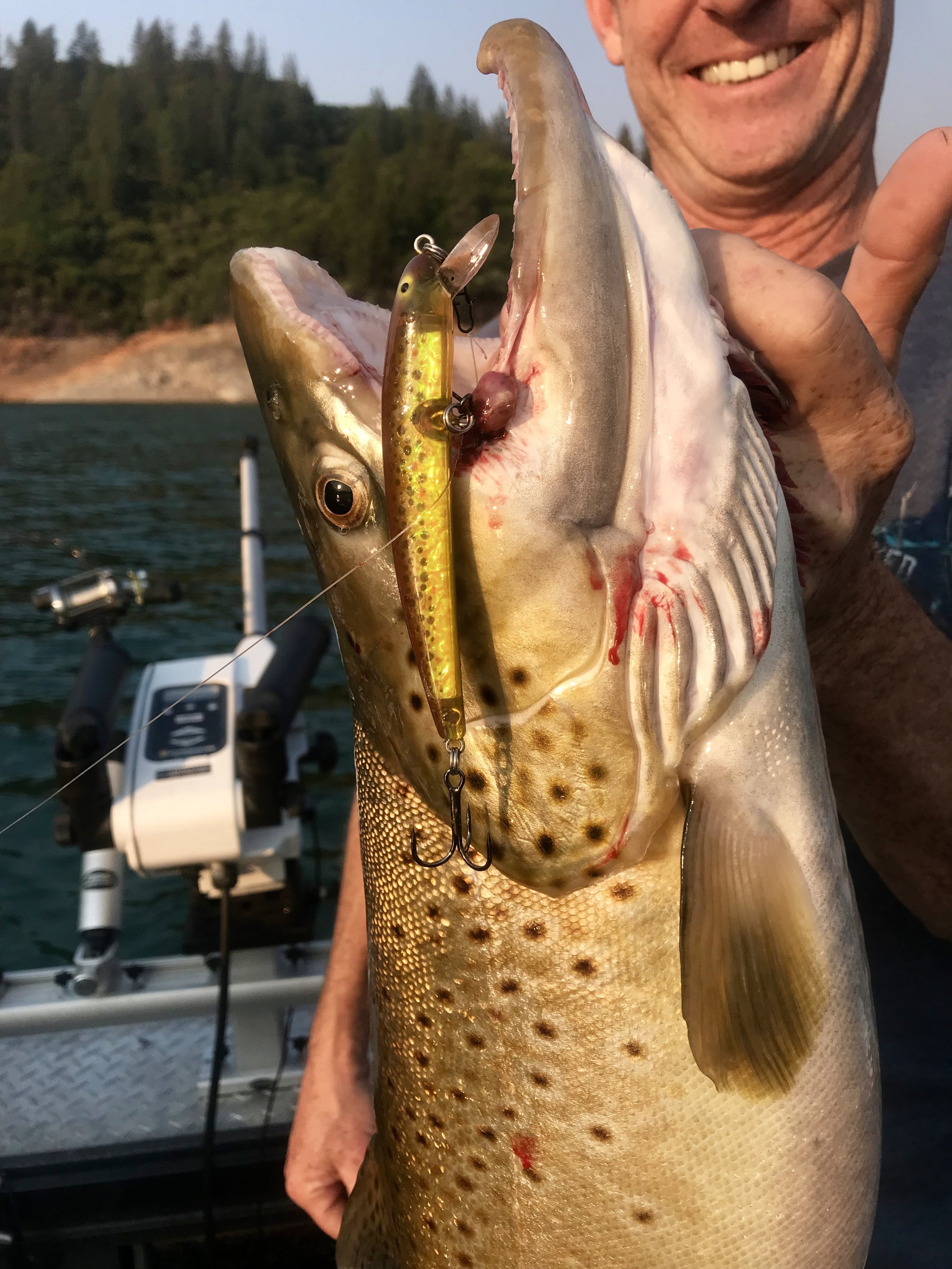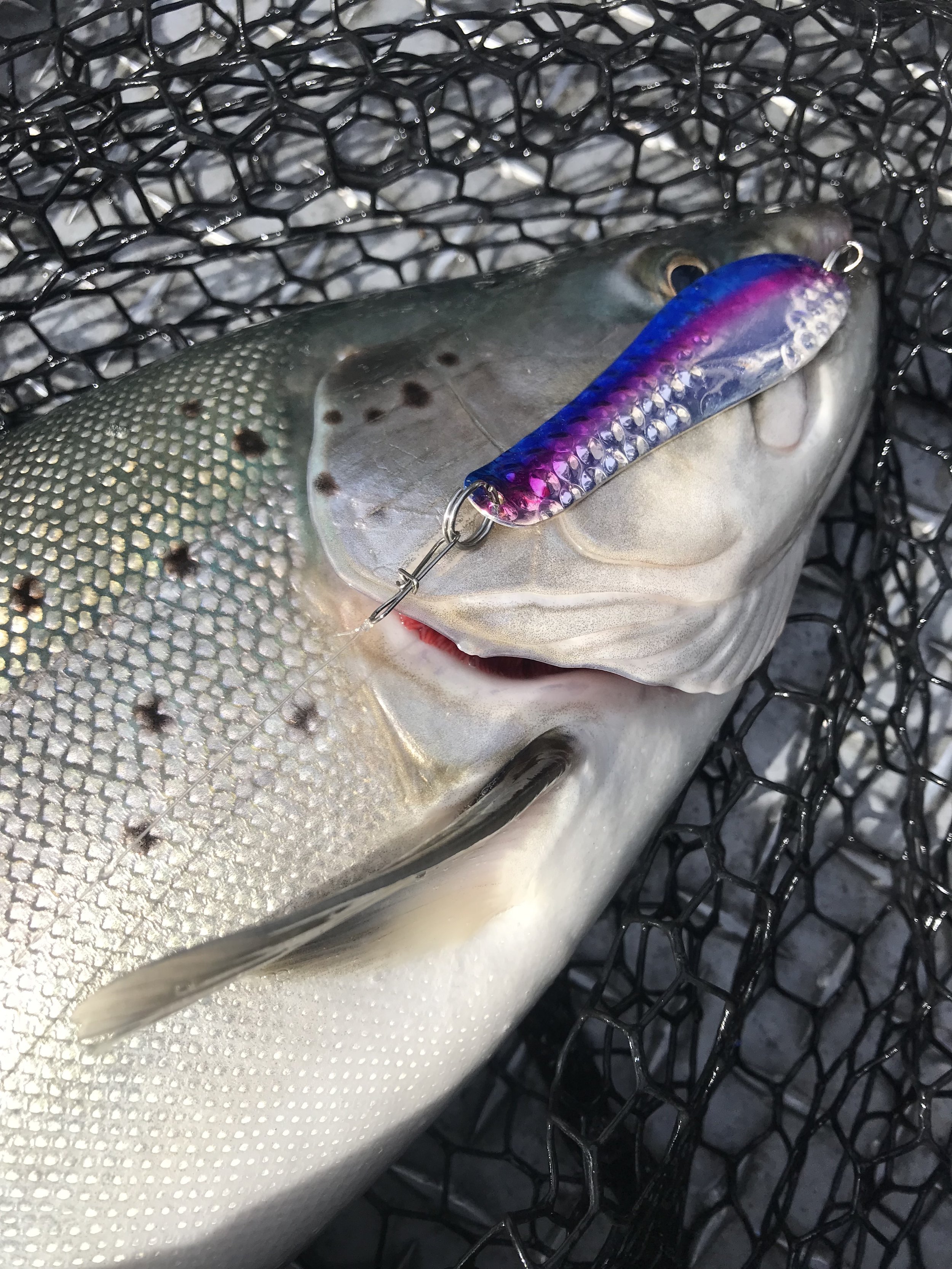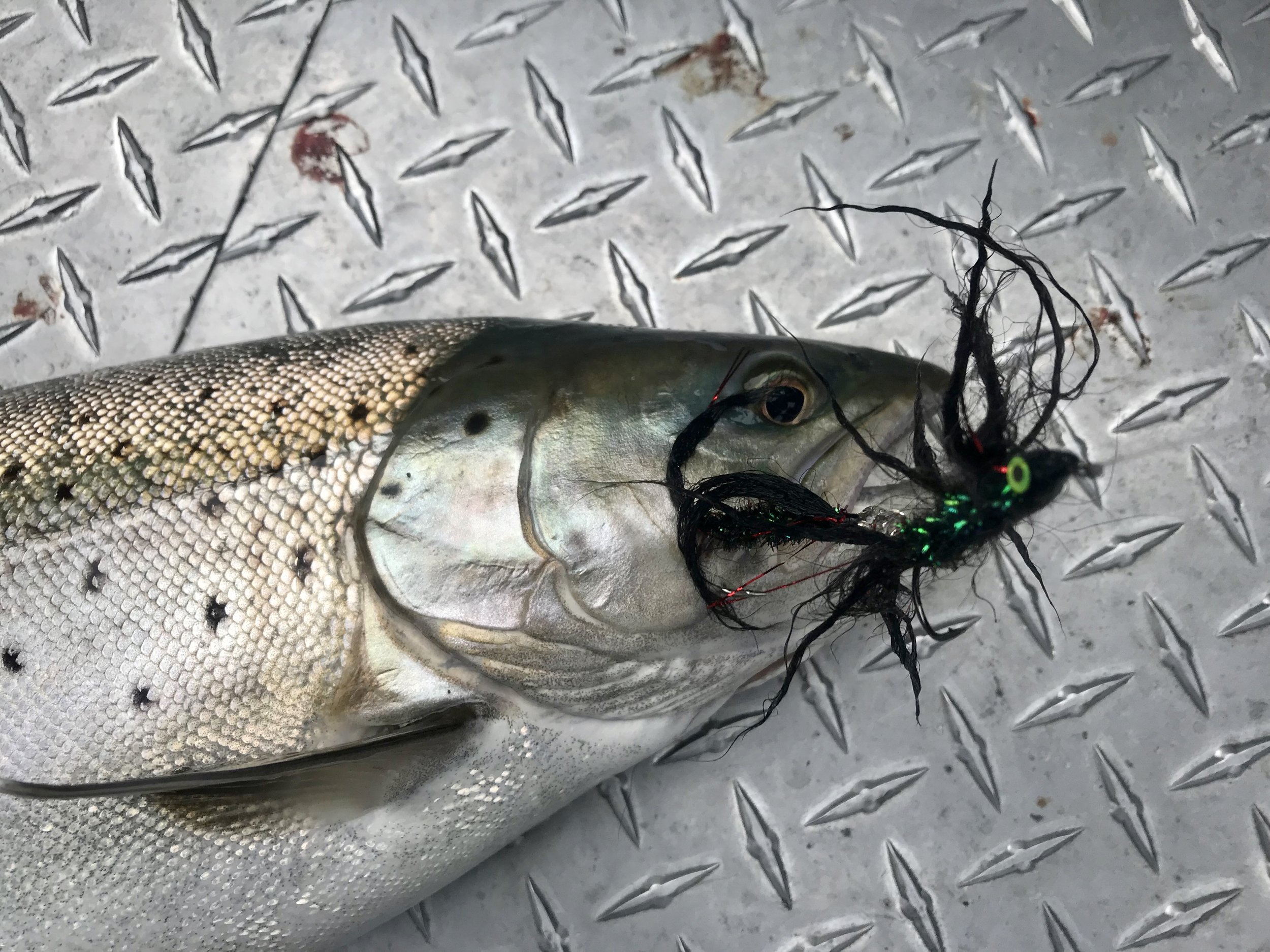SHASTA LAKE SUMMER FISHING
Shasta Lake mornings are pure magic and the trout fishing is just one of the things that make summer on Shasta Lake so special. Catching fish on northern California’s largest reservoir is most often considered a small bonus considering all of the great things you’ll see throughout the day.
Its no secret that Shasta Lake summertime fishing is my most productive time of the year to fish for rainbow and brown trout. Its the the best season of the year to catch both big numbers and big fish all in one day! Yes, its hot on the lake most days and in the afternoon the water can be busy with houseboats, ski boats, and jet skis, but rarely is it a problem to find solitude on Shasta even at its peak in July through the end of August. Perfect weather, pristine water, and hundreds of thousands of trout guarantee great days of fishing on Shasta Lake in the summer. Many of my clients come back year after year for another experience of what they have often called, “the best fishing they have ever experienced”.
FINDING SUMMER TROUT ON SHASTA!
Shasta Lake is in a constant period of change each and every month of the year, but summertime brings the most consistent pattern I observe during the year, and the trout are by far the easiest to find beginning in late June and early July. With that point being stated, I consider the best summer trout fishing pattern on Shasta to be between the months of July, August, and September. Two factors make this time of the year on Shasta Lake predictable and easy to catch lots of trout. First, we see the primary food source for the trout, Thread Fin Shad, during late spring on through late fall in the main body of Shasta Lake. Secondly, the Shad are easily accessible to the trout in very large schools making for a constant food source that keeps the trout in a relatively small area of the lake. This energizes the Shasta Lake trout and they are on a Shad feeding frenzy and a good bite every day of the summer.
As the Shad show up in good numbers in late spring they will migrate down into the main body of Shasta Lake between the Pit River Bridge (I-5) and Shasta Dam where they will stay until fall. When the Shad first arrive, they can be found along the shorelines in the warmest water where they spawn and also feed on Plankton that are pushed by prevailing morning winds from the north that drive the Plankton blooms to Shasta’s south shore. This is important to note as it will serve anglers well during the summer when they are trying to locate feeding schools of trout or the nomadic trophy size rainbows and browns. Like all bodies of water, there is a food chain and if you pay attention, you will know that following the bottom of the food chain will lead you to the top of the food chain. This is key when looking for trophy size rainbows and browns. The gamefish are never far from the baitfish.
Find the Shad and you’ll find the trout in Shasta Lake!
So now that we have an idea of why the Shad are so important, lets look at where we will typically find them during the peak of the summer fishing season. Shad are temperature sensitive as are many species of fish. In Shasta Lake, Shad can often be found near the surface in the spring and in the fall. The water surface temperatures are such that these Shad will stay in the upper end of the water column in Shasta Lake until summer arrives and the water surface warms above 70 degrees. When we start to see temps above the mid 70’s and into the 80’s the Shad will start to drop deeper and deeper below those warmer surface temps and stay in water that accommodates their comfort level. As they go deeper, you will find that they tend to school up and form massive bait balls will be easy to spot on sonar. Like most baitfish, shad will ball up at an attempt to protect themselves from feeding trout, salmon, bass, etc.
HOW DEEP DO I FISH?
In the picture above there are a few things to consider when trying to figure out where to drop your trolling gear should you see the same thing on your screen when you are fishing. In this example, the top 20’ of the water in this screen shot shows a bright color line. This interpretation by the sonar unit indicates warm water or a warm water section of the lake. This line of warm water can extend down as far as the warm water progresses throughout the summer months. Its a great clue in most cases, that this area of the lake will hold baitfish and warm water species such as spotted bass in Shasta Lake. The green dots you see on the screen in the warm water are likely bass or smaller fish up in the feeding zone where the Shad are.
The long green lines represent the downrigger balls and also can help show the angler where their lines are traveling in relation to the locations of the fish/baitfish. As you can see, I like to run my baits in the zone where warm water meets cold. I’m also trolling my gear, in this case, at the top of the massive bait ball. Trolling gear in or above the bait is a good practice because trout will be looking up at the bait in warmer water while they occupy the cooler water temps below the bait. if you look closely, you’ll see fish activity in the warm water zone. Active fish will often appear as streaks, long arches, or even long lines as they follow trolling gear. The last thing I’ll point out are the 3 big fish that are sitting down at the 60’ line. These fish are clearly sitting down in the dark and are not active or anywhere near the bait school suspended at the 40’ line. You can drop lines down to 60’ in an attempt to get these fish to bite, but they are clearly not feeding and are more difficult to catch. This picture tells a story and if you put all the pieces together, you’ll understand whats going on down there and where you should have your gear.
The use of a temperature and depth reading device is very helpful and takes all the guesswork of where you should have your gear set. This shot was taken on 6/7/19 and shows that the surface water temp is 69.3 degrees, my downrigger ball is at 54’ feet and the temperature at the ball is 55.5 degrees. This depth yielded a 5 lb brown trout for one of my clients today so its worth a look, don’t you think?
Every week of the summer this picture will change and you will make small adjustments to stay on top of the feeding trout. Without a doubt, you’ll likely find the trout and baitfish to be a little deeper every week until fall arrives and the lake starts to cool off again. You can almost certainly count on fishing deeper every week you search for Shasta Lake trout during summer. As an example, in May, most of the trout will be in the 20-30’ mark. By June, you’ll find them in 40-60’ of water, and by July, 60’ plus. Almost every year, I’ll finish my summer trout season fishing below 110’ feet of water. There are no set rules for what depth to start fishing, but I find that most of the time I start setting my gear at 60-65 degrees, wherever that may be. My reasoning is that I know the Shad will often times be above that temperature line, and the trout, (active feeders) will be out of their preferred temperature (mid to low 50’s) looking for a meal before dropping back down into the cold water zone.
WHAT KIND OF GEAR DO I NEED?
Gear selection is a broad subject and I could go on forever writing about all the choices you have out there. Because you’ll be fishing deep in the summer months, downriggers are a top choice for getting your gear down where the trout are. There other ways to get your gear deep and a little research will present many options for you. As far as baits to send down on the riggers, if you stick to one pattern for the July-September timeframe on Shasta Lake, stick with what the trout are feeding on, a Shad pattern! Small silver spoons, flies, hoochies, etc. in the 1”-2” range are top producers early in the summer. As summer wears on, the size of your presentations can increase and by summers end a 3” presentation may be a perfect size.
When you catch trout and harvest them for the dinner table, check out the size of the Shad in their stomach’s. Most often the Shad will be about the size of a silver #1 Dick Nite Spoon. Stick a small hologram eyeball to it and bingo, you have a perfect Shad imitation that will get bit over and over again. Match the hatch and you will find success. Another very effective piece of tackle is a small dodger in front of that spoon you’re fishing. Remember, Shad are a schooling fish and a dodger looks like a small group of baitfish. The straggler (the small Dick Nite spoon) is the easy target and gets bit time and time again.
Intuition plays a major role in my day, every day. Often times, turning my back to clients to let lines out gives me a few moments to focus on a plan for my next move. Brief breaks in interaction or conversation with my clients are almost always a period of concentration directed at what needs to be done to get more bites.
Clients that fish with me know that I use a lot of different techniques and different types and sizes of lures. I couldn’t possibly write all of my little tricks of the trade in this article alone, but I can tell you that most of the tactics and gear I use are already being used by thousands of anglers and fellow charter captains. You all live in a world where every piece of information imaginable is at your finger tips via the internet. The only thing that can’t be learned or provided in written form is intuition. There are no shortcuts to gaining intuition, its something thats developed by spending hundreds or thousands of hours on the water trying to catch fish.
SHASTA LAKE TROPHY TROUT
Bay Rat Lures shallow diving stick baits will produce big trout sometimes when nothing else will.
Anyone who follows my reports and blogs knows I like to hunt for big Shasta Lake rainbows and browns. Its not hard to catch a big trout on Shasta Lake as there are many. It is difficult to catch them day after day and some days seems impossible to catch them at all. They are finicky to say the least and most days require that you do everything right. Its good luck to catch a big multi pound trout a few times a year, but catching over a hundred 5 lb. to 10 lb. class trout in a year isn’t just luck. Simply put, its hard work that requires hundreds of hours on the water.
Trinidad Tackle Optimizer spoons are a favorite when it comes to presenting a high vibration, large profile option for big trout.
The common denominator involved in catching trophy trout involves two things. Confidence and patience. Many new clients ask what they need to bring for their day on the lake when fishing with me. Besides the obvious, I ask them to have a two rod license and to bring a PFA (positive fishing attitude). Most professional athletes will tell you that their play is 90% mental and 10% physical. In my mind, fishing professionally is no different. Keeping your head in the game until the last line comes in at the end of the day is the biggest success factor when fishing for trophy trout. I do most of the work for my clients in that area, but if you have high expectations of catching big trout everyone in the boat needs to contribute to the positive vibe in the boat. Big fish can feel your doubt and will readily turn a cheek to your low energy presentations.
Arctic Fox Trolling Flies are a great presentation when stealth is required to get strikes from big, weary browns and rainbows.
I’ve caught big trout on 5” herring and I’ve caught them on a small Arctic Fox Trolling fly. At different times big fish will react to a wide variety of presentations. I’ve written about several lure/fly presentations over the years that I use to catch big trout on Shasta Lake. I only write about them because they absolutely work. If you read my social media at all, you have seen comments on my posts by many anglers explaining their successes using a number of the products I support. Tackle manufacturers such as Trinidad Tackle (Trinidadtackle.com), Bay Rat Lures (Bayratlures.com), and Arctic Fox Trolling Flies (trollingflies.com) can all attest to the increase in sales they have seen because of the success these presentations bring to the big fish anglers and fishing guides.
If you are specifically targeting big trophy class trout in Shasta Lake, these three presentations are almost always my key to success on any given trip. one thing that makes these items so effective is that they can all be used in combination (at the same time). I have managed to get double hook ups with big browns trolling an Optimizer spoon and an Arctic Fox Trolling Fly at the same time at the same speed. That my friends is a piece of info to remember!
FINAL THOUGHTS FOR SUMMERTIME SHASTA LAKE TROPHY TROUT.
I’ve given you a lot of information to digest for the upcoming summer season on Shasta Lake, but not too much I think. Everything I have written has helped me find success on Shasta Lake and has helped me become the #1 booked fishing guide on the lake as well. Not only have I helped put hundreds of people on some of the best fishing they have ever experienced, i’ve also helped dozens and dozens of anglers become next level fishermen that are now catching their biggest rainbows and browns ever. I am humbled by the relationship I’ve developed with my clients and acquaintances on Shasta Lake and I wake up grateful every day knowing I have the opportunity to be a fishing guide on this beautiful and bountiful body of water. I hope I’ve helped the readers of this article in some way and hope that many of you will choose to come experience first hand catching some big rainbows and browns with me this summer. Tight lines!
Captain Jeff Goodwin

